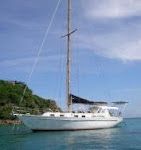The sail from the Saintes to Guadeloupe was a rorty one with the 8 knots showing most of the way despite having the second reef in and only the staysail. But it was short and things soon calmed down in the lea of Guadeloupe.
PIGEON ISLAND SNORKELWe snorkeled at Pigeon Island and I got a reminder of just how special it can be. The vix was fantastic the coral spectacular and the fish were everywhere and not the least bit camera shy. I suspect that there is some feeding going on but who cares. Black triggers reticulated horned box fish and small groupers were everywhere
The next stop was Deshaies and the obligatory visit to the botanical gardens.
I will let the pictures do the talking.
The next job was to see if I can get the fitting I need to redo the base os the inner forestay. I thought I had it cracked but somehow the thread was just oversize.
It seems it might have been something made as a one off initially.
ANTIGUA BOUND
We made the passage over to Antigua without the staysail which was no big deal as with a single reef in the main and about 60 % of the genoa rolled out we were doing 7.5 to 8 knots with the wind just forward of the beam. The seas were down and it was a great sail over in the sunshine.
We are tucked up off the beach just outside Jolly Harbor and the Christmas winds that relented for a day to give us a pleasant sail over from Guadeloupe to Antigua are blowing hard again
So it is off to Deep Bay and a chance to see the wreck that lies just beneath the surface.
he Andes was a three-masted steel sailing barque built in England in 1874. In early June of 1905, it left Trinidad with a cargo hold full of pitch (tar) bound for Chile.
They first sailed northeast before sailing south in order to sail the trade winds to Cape Horn, but had a problem approaching Antigua. The barrels of pitch were rubbing against each other and this generated a lot of heat, enough to create smoke that started drifting above decks.
The captain of the ship wanted to anchor in St. Johns Harbor, but the harbormaster directed them to Deep Bay. The busy St. Johns Harbor was no place for a burning ship – it would have been a hazard to any other vessel in the harbor.
So they anchored in Deep Bay, and as soon as the hatches were open enough oxygen was introduced to the cargo holds to ignite the tar. The ship burned and sank bow first, but all of the crew was spared.
Since its sinking in 1905, an abundance of coral, gorgonians, and sponges have taken hold of the steel hull and reef fish have moved in.
Tuesday, February 20, 2018
Subscribe to:
Post Comments (Atom)













No comments:
Post a Comment